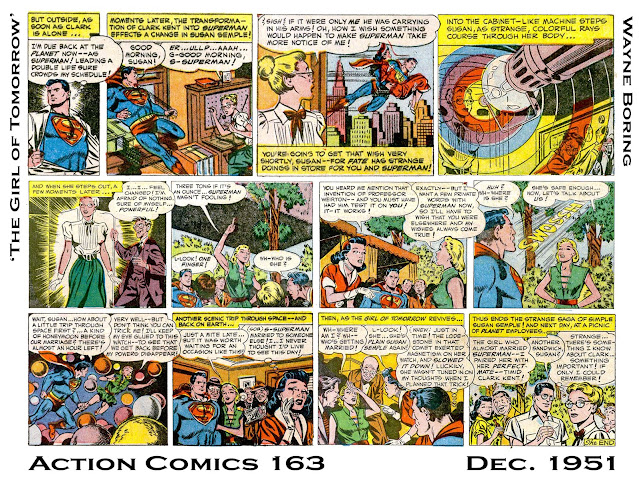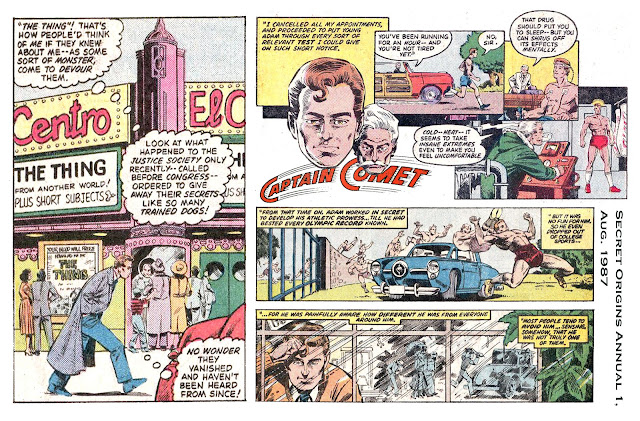December 1951: The Girl of Tomorrow
Superman encountered several super-females during his long career, including his own cousin and various amped-up versions of Lois Lane and Lana Lang. But Susan Semple was a variation on the theme.
Unlike the others, this “Girl of Tomorrow” didn’t have powers that directly paralleled Superman’s. Introduced in Action Comics 163 (Dec. 1951), she appeared instead to be a female counterpart to Captain Comet, a DC character who’d been introduced in Strange Adventures seven months before.
Captain Comet was, after all, himself a Superman updated from the 1930s to the 1950s, the era of the flying saucer and the atom bomb. His extraordinary abilities were more mental than physical. This new Man of Tomorrow’s powers included telepathy, telekinesis and ESP, and the Girl of Tomorrow shared them.
Bespectacled Daily Planet receptionist Susan Semple mooned over Superman, and when she heard eccentric scientist Prof. Weirton’s claims that he could transform ordinary people into super beings, she was first in line for human experimentation.
Weirton’s bulbous glass ray gun — a signature touch by artist Wayne Boring — advanced Semple’s evolution by a million years. There, she outdid Captain Comet, a mutant born a mere 100,000 years ahead of time.
“I… I… feel changed!,” says the suddenly beautiful Susan. “I’m afraid of nothing, sure of myself… powerful!”
Like Green Lantern, the Girl of Tomorrow has only 24 hours before her powers will wear off.
Trading her dowdy Victorian outfit for a sleek, understated green tunic, she shows up at a charity fair to show up Superman. She uses her telepathy to learn more than his x-ray vision reveals, and employs her telekinesis to lift a three-ton steel block from his hands.
“Just a simple case of mind over matter,” she explains. “With my powers of concentration, I can move any object wherever I want, at lightning speed!”
And one of those objects she whisks out of the way is Lois Lane, who has recognized her as Susan Semple.
“You machine-made freak!” fumes the furious reporter. “Wait till your powers wear off! Don’t just stand there, Superman! Take me back to the Planet — out of her sight!”
“You’ll have to learn to stop wasting Superman’s valuable time with your frivolous requests, Lois!” replies Susan, who admittedly does have a point. “I’ll get you back to the Planet with my powers of concentration!”
“I don’t want your help! I want… Eek!” exclaims Lois as she hurtles through the air. “Superman! Are you going to let her do this to me?”
He is, as it turns out.
“Whew!” says Superman. “Life was difficult enough with one girl! Now what?”
Now his secret identity is at risk, because the Girl of Tomorrow’s telepathy has revealed it to her. She announces to Lois that she and Superman will wed, mentally warning Superman not to contradict her.
“Why, I… Er… it… wouldn’t be… Er… chivalrous to … Er… tell a lady she’s a liar, Lois,” Superman says sheepishly.
“In other words, she’s telling the truth!” Lois replies. “Oh, don’t ever talk to me again, you henpecked hunk of super-muscle!”
With her mind-reading abilities, the Girl of Tomorrow helps Superman capture Vince Moon, a criminal he’s been after for months. But Superman, finding he can’t hide from her even by speeding through space, is finally forced to face the music and a justice of the peace.
But before she can say “I do,” Semple becomes simple once more, her knowledge of Superman’s secret disappearing along with her powers.
During their space jaunt, Superman had used the lodestone in a comet to retard the mechanism in Susan’s wristwatch.
The story closes at a Daily Planet picnic, with Lois and Perry White mocking the former superwoman and her escort.
The editor remarks, “The girl who almost married Superman! I paired her with her perfect mate — timid Clark Kent!”
“Another sandwich, Susan?” asks Clark.
“Strange — there’s something I know about Clark, something important,” thinks Susan. “If only I could remember!”
Captain Comet himself would run across other beautiful, futuristic superwomen during his three-year run. First it was the 19-year-old mutant Radea from the planet Hyperba (The Girl from the Diamond Planet, Strange Adventures 12, Sept. 1951) and then a super-powered girl from the year 100,000 (Captain Comet vs. Miss Universe, Strange Adventures 26, Nov. 1952).
Action Comics 163 appeared during the postwar romance comics era when DC and Marvel began displaying women prominently on the covers of their superhero comics in an attempt to expand their female (and older male) readership.
Given that effort, I’m a little surprised that Tomorrow Girl never reappeared.




George Blake wrote:
ReplyDeleteI don’t suppose the inventor and his miraculous machine were mentioned again.
Another gadget that operates using some rare element and once used cannot be replaced?
That Susan did not see through Superman’s scheme was probably due to a flush of emotion, the excitement of her dream coming true. Fair enough.
Thanks for posting.
I replied:
Superman had some BS explanation for how he was momentarily able to evade her telepathy. Yours is better.
I kind of love the panel in which she so casually makes Lois zip off into the sky.
ReplyDeleteBob Doncaster wroe:
ReplyDeleteModern comic writers need to bring back “er”. I miss it.
Bruce Kanin wrote:
ReplyDelete"...I’m a little surprised that Tomorrow Girl never reappeared." Agreed, although back then, other than the established characters (including villains), there tended to be more "one off" appearances by folks such as Susan Semple.
I replied:
This makes me realize that they could have introduced a "Supergirl" in 1951 instead of 1959. That would have been interesting.
Vincent Mariani wrote:
ReplyDeleteThe late 1940s introduced quite a few DC female characters; notably Black Canary and Harlequin. But only Wonder Woman, who had been around since 1942, had the star power to have her own title.
Michael Fraley wrote:
ReplyDeleteWow, if you advanced Superman (or even me, for that matter) a million years in those old comics, I would have just gotten an enormous head. She gets an extreme makeover! How unfair is that? Actually, this reminds me of a few source materials from the 1930s. The first is "The Man Who Evolved," by Edmond Hamilton, which was ripped off by The Outer Limits for their "Sixth Finger" episode. At one stage in his advancement, the man in the evolution booth is the perfect specimen, similar to what we see here. That's before he becomes a bulb-headed freak, and finally protoplasm. Another source would be Stanley G. Weinbaum's short story, "The Adaptive Ultimate," about a drab woman transformed into a beautiful (when she needs to be) villain who has an astounding healing factor, and many other abilities besides.
Foster H. Coker III wrote:
ReplyDeleteWhat a great post! Susan seems fun, I wish she had become a recurring character, even if only every few years.
Paul Zuckerman wrote:
ReplyDelete"...When she heard eccentric scientist Prof. Weirton’s claims that he could transform ordinary people into super beings, she was first in line for human experimentation."
Just another day in Metropolis, I guess. Nobody seeming to care about bad side effects! So, what happened to the machine? Lois seemed to be particularly unfriendly and scared this time out!
Nice Boring art. I wish they would reprint the stories from this period, or did the Archives get this far? I haven't bought any of those because they are too tall for my shelves. And a pain to carry around.
Thomas Van Horne wrote:
ReplyDelete"Tomorrow Girl" would make a nice addition to a hypothetical 1960s DC lineup -- dominated by the Challengers (working for June and Computo), with Adam Strange (known on Earth as "Rocketman" perhaps) and Captain Comet himself.
Bob Bailey wrote:
ReplyDeleteExcellent post, Dan. I've often wished they had done a sequel to this never-before-reprinted story.